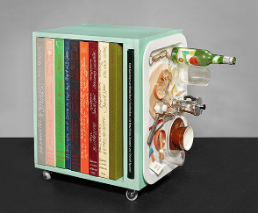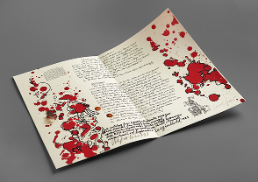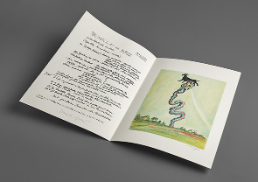In Daniel Spoerri’s library of recipe folders, offal is presented artistically as a central element in the transformation of food.
By Carla Gehler

© Photo: NL, Simon Schmid
A fascination with meat and offal has been an enduring feature of Daniel Spoerri’s culinary explorations since the early 1960s. Back then, he purchased his first bull’s testicles in a triperie in Paris, assuming they were “white kidneys”. Later, in Greece, he encountered a soup made from the offal of Easter lamb called magiritsa, which is eaten after the strict fast, while in Brittany he discovered the custom of consuming blood sausage at Christmas. In his pseudo-scientific “A dissertation on Keftedes” (written between December 1966 and January 1967 on the Greek island of Symi) he expatiates in literary fashion on how left-over meat is rendered more palatable by turning it into meatballs.
Visceral recipes

© Photo: NL, Simon Schmid
The “Rezeptmappen-Bibliothek” (Library of recipe books), published between 1984 and 1990 by Francesco Conz in Verona, presents various ways of preparing offal through a variety of text and image combinations. Spoerri collected and edited the recipes, while his artist friends Fritz Schwegler, Roland Topor, Bernhard Luginbühl, Katharina Duwen, Alfred Hofkunst, Bernhard Johannes Blume, Sabine Schroer, Christian L. Attersee, Dieter Roth and Karl Gerstner provided the illustrations. Yet this is not a conventional series of cookery books organised according to familiar criteria such as starters, main courses and desserts. Instead, the recipes are arranged by organs and body parts, because Spoerri’s intent was to serve up animals as complete entities, with all their organs. The first volume, in which he set down his favourite soup recipes, was thus followed by recipes for tripe, blood, lungs, tongues, testicles, brains, feet and fat.
Daniel Spoerri is himself an enthusiastic collector of cookery books. However, he is interested not just in methods of preparation but also, and in particular, in developments within cultural history: with the fact that eating an entire animal can have a special socio-cultural significance. Offal, for example, frequently plays a key role in rituals and ceremonies. In many cultures, eating brains is believed to strengthen the mind and body, while testicles are supposed to possess aphrodisiac qualities. Within European culture, meanwhile, certain body parts had by the early 20th century been dismissed as inedible, often for hygiene reasons. As animals come to be regarded more highly, the trend is shifting once again, towards eating the whole beast: from nose to tail.
The cycle of digestion and the cycle of life

© Photo: NL, Simon Schmid
For Spoerri, to study food is to study life, since eating is a fundamental human need, given that “our two most important drives are, after all, self-preservation and procreation, […].” When offal is made into food, with stomachs and intestines being processed into tripe and sausages, the very organs that are used to digest food are themselves consumed. This cycle is also addressed in the film “Resurrection” (1969, conceived by Daniel Spoerri and shot by Tony Morgan), in which it is shown in reverse. The film begins with an image of human excrement, the end product of digestion, and then moves backwards into the intestines, then to the steak on the plate, the piece of raw meat in the butcher’s shop, and finally the reborn cow in a field.
In the end, even the prime cut of meat is digested in the same way as tripe, which is itself part of the digestive tract. In his library of recipe folders, Daniel Spoerri focuses his attention on offal, which is regarded by many consumers as inferior to “pure” muscle meat, and invites us to reflect on meat’s true value.
Daniel Spoerri was born in Galati, Romania, in 1930 and died in Vienna in 2024. Following a dance training, he is active as a dancer, choreographer, director and editor from 1949 until, in 1960, he embarks on a career as a self-taught visual artist. That same year he is a founder member of the artist group known as the Nouveaux Réalistes, and achieves international recognition with his “tableaux-pièges” (snare pictures). Starting in the 1960s, Spoerri makes a name for himself as a food artist, and is the founder of Eat Art.
Bibliography and sources
- Daniel Spoerri: Rezeptmappen-Bibliothek, hg. von Francesco Conz, 1 Kasten auf Rollen und 10 Rezeptmappen, Verona/Uebersdorf 1984–1990
- Daniel Spoerri: Dissertation sur le ou la Keftédès, in: Daniel Spoerri (Hg.), Le Petit Colosse de Simi, Il piccolo colosso di Simi, Der kleine Koloss von Simi, No. 3, The Nothing Else Review, réd. en chef et garçon de courses: Daniel Spoerri, Selbstverlag [Auslieferung Galerie Bruno Bischofberger], Simi 1967
- Daniel Spoerri: J’aime les kéftèdes, Paris: Forcalquier, Edition Robert Morel 1970
- Daniel Spoerri: Gastronomisches Tagebuch. Itinerarium für zwei Personen auf einer ägäischen Insel nebst einer Abhandlung über den oder die Keftedes, Neuwied/Berlin: Luchterhand Verlag 1970
- Leda Cempellin: Eat Art: beyond food, in: dies.: The Ideas, Identitiy and Art of Daniel Spoerri. Contingencies and Encounters of an ‘Artist Animator’, Wilmington Delaware: Vernon Press 2017, pp. 111–140
- Cecilia Novero: Daniel Spoerri’s Gastronoptikum, in: dies.: Antidiets of the Avant-Garde. From Futurist Cooking to Eat Art, London: University of Minnesota Press 2010, pp. 145–208
- Utz Jeggle: Runterschlucken. Ekel und Kultur (1997), in: Kikuko Kashiwagi-Wetzel, Anne-Rose Meyer (Hg.): Theorien des Essens, Berlin: Suhrkamp 2017, pp. 396–412
Last modification 10.05.2021
Contact
Swiss National Library
Prints and Drawings Department
Hallwylstrasse 15
3003
Bern
Switzerland
Phone
+41 58 462 89 71








